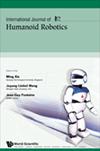从人体运动捕捉到类人空间协调
IF 1.6
4区 计算机科学
Q4 ROBOTICS
引用次数: 0
摘要
本文描述了一种在仿人机器人环境下翻译人类空间协调的方法。一旦人类运动被捕获,我们强调描述运动的协调关系。关系和逆运动学应用于虚拟人形,这是人(拟人化比例)和机器人(关节构型)之间的折衷。此外,我们量化了所有需要适应一个真正的人形,如缩放和平衡。最后,将该方法应用于一个特定的类人机器人(称为NAO),以说明和比较一些初步结果。本文章由计算机程序翻译,如有差异,请以英文原文为准。
From Human Motion Captures to humanoid Spatial Coordination
This paper describes a methodology translating human spatial coordination in a humanoid robots context. Once the human locomotion is captured, we highlight coordination relations describing motions. Relations and inverse kinematics are applied to a virtual humanoid, which is a tradeo® between human (anthropomorphic proportions) and robot (joints con ̄guration). Further, we quantify all required adaptations for a real humanoid, such as scaling and equilibrium. Finally, this methodology is applied to a speci ̄c humanoid robot (called NAO) in order to illustrate and compare some preliminary results.
求助全文
通过发布文献求助,成功后即可免费获取论文全文。
去求助
来源期刊
CiteScore
3.50
自引率
13.30%
发文量
29
审稿时长
6 months
期刊介绍:
The International Journal of Humanoid Robotics (IJHR) covers all subjects on the mind and body of humanoid robots. It is dedicated to advancing new theories, new techniques, and new implementations contributing to the successful achievement of future robots which not only imitate human beings, but also serve human beings. While IJHR encourages the contribution of original papers which are solidly grounded on proven theories or experimental procedures, the journal also encourages the contribution of innovative papers which venture into the new, frontier areas in robotics. Such papers need not necessarily demonstrate, in the early stages of research and development, the full potential of new findings on a physical or virtual robot.
IJHR welcomes original papers in the following categories:
Research papers, which disseminate scientific findings contributing to solving technical issues underlying the development of humanoid robots, or biologically-inspired robots, having multiple functionality related to either physical capabilities (i.e. motion) or mental capabilities (i.e. intelligence)
Review articles, which describe, in non-technical terms, the latest in basic theories, principles, and algorithmic solutions
Short articles (e.g. feature articles and dialogues), which discuss the latest significant achievements and the future trends in robotics R&D
Papers on curriculum development in humanoid robot education
Book reviews.

 求助内容:
求助内容: 应助结果提醒方式:
应助结果提醒方式:


